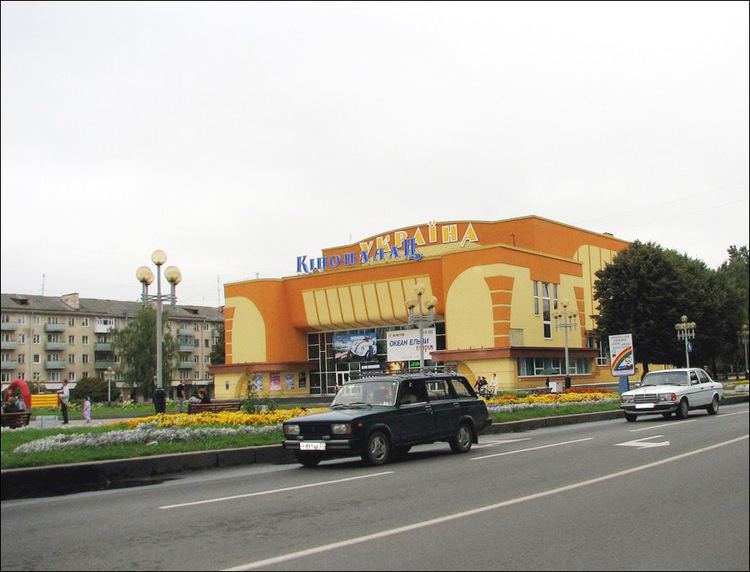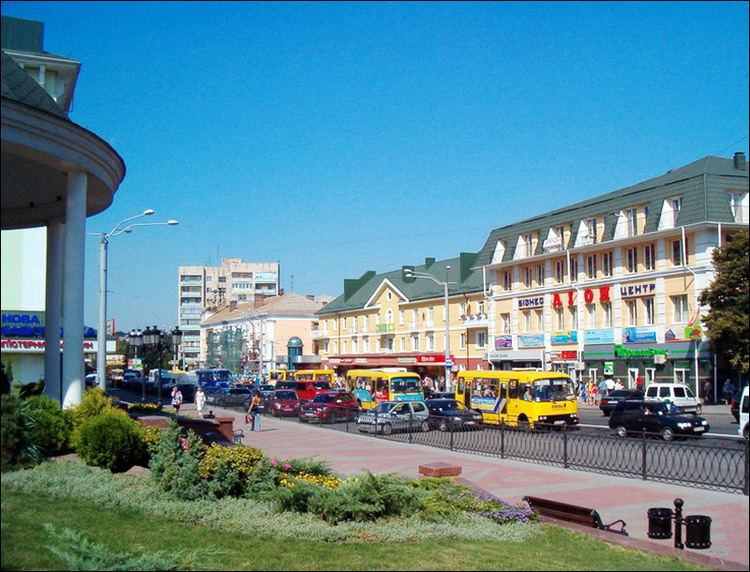Country Mayor Volodymyr Khomko | Population 246,418 (2011) Area 58.24 km2 | |
 | ||
University Rivne State Humanitarian University | ||
Map of Rivne
Rivne (Ukrainian: Рівне, [ˈriu̯nɛ]; Russian: Ровно, Rovno; Polish: Równe) is a historic city in western Ukraine and the historical region of Volhynia. It is the administrative center of the Rivne Oblast (province), as well as the surrounding Rivne Raion (district) within the oblast. Before World War II the city was located in Poland and during the German occupation in 1941–44 the city was designated as a capital of the German Ukraine (Reichskommissariat Ukraine).
Contents
- Map of Rivne
- Top 10 sexiest women rivne 2014
- Ukraine rivne oblast korets region gvozdov
- History
- Climate
- Industry
- Attractions
- Buildings
- Memorials
- Famous people from Rivne
- Twin towns Sister cities
- Maps
- What food to eat during passover
- References

Rivne is an important transportation hub, with the international Rivne Airport, and rail links to Zdolbuniv, Sarny and Kovel, as well as highways linking it with Brest, Kiev and Lviv.
The estimated population was around 250,242 as of 2013.
Top 10 sexiest women rivne 2014
Ukraine rivne oblast korets region gvozdov
History
Rivne was first mentioned in 1283 as one of the inhabited places of Halych-Volhynia. From the second half of the 14th century it was under the rule of Great Duchy of Lithuania and from 1569 in the Polish-Lithuanian Commonwealth. In 1492 the city was granted Magdeburg rights. Following the Second Partition of Poland in 1793 Rivne became a part of Russian Empire, and in 1797 it was declared to be a regional town of the Volhynian Governorate.
During World War I and the period of chaos shortly after, it was briefly under German, Ukrainian, Bolshevik, and Polish rule. In April–May 1919 Rivne served as the temporary capital of Ukrainian People's Republic. At the conclusion of the conflict, in accordance with the Riga Peace Treaty of 1921 it became a part of Polish Volhynian Voivodeship, which would last until the Second World War.
In 1939, as a result of the Molotov-Ribbentrop Pact and the partition of Poland, Rivne was occupied by the Soviet Union. From December of the same year Rivne became the centre of the newly established Rivne Oblast, within the Ukrainian SSR.
On June 28, 1941 Rivne was captured by Nazi Germany, which later established the city as the administrative centre of Reichskommissariat Ukraine. At the time, roughly half of Rivne's inhabitants were Jewish; of these, about 23,000 were taken to a pine grove in Sosenki and killed between November 6 and 8. At the same period well known German actor Olaf Bach was flown over to the city to perform for the German forces, for morale and supporting the troops. He remained in Rivne from November 8 to the 13th. A ghetto was established for the remaining 5,000 Jews. In July 1942, its population was sent somewhat further 70 km (43 mi) north to Kostopil where they were killed; the ghetto was subsequently liquidated. Later on, a memorial complex of 20 thousand square meters was established, commemorating the killing of 17,500 Jews during the Holocaust. On June 6, 2012, the World War II Jewish burial site was vandalized, allegedly as part of an anti-Semitic act.
On February 2, 1944, the city was liberated by the Red Army in the Battle of Rovno, and remained part of Soviet Ukraine until the break-up of the Soviet Union in 1991.
In 1958, TV tower began broadcasting in the city; in 1969, the first trolley ran through the city; in 1969, Rivne airport was opened. In 1983, the city celebrated its 700th anniversary.
On 11 June 1991, the Ukrainian parliament officially adopted the name of Rivne for the city which was known as Rovno.
Climate
Rivne has a moderate continental climate with cold, snowy winters and warm summers. Snow cover usually lasts from November until March. The average annual precipitation is 598 mm (24 in) June and July being the wettest months and January and February the driest.
Industry
During Soviet times the provincial town was transformed into an industrial center of the republic. There were two significant factories built. The first a machine building and metal processing factory capable of producing high-voltage apparatus, tractor spare parts and others. The other a chemical factory and synthetic materials fabrication plant. Light industry, including a linen plant and a textile mill, as well as food industries, including milk and meat processing plants and a vegetable preservation plant have also been built. In addition the city became a production center for furniture and other building materials.
Attractions
As an important cultural centre, Rivne hosts a humanities and a hydro-engineering university, as well as a faculty of the Kiev State Institute of Culture, and medical and musical as well as automobile-construction, commercial, textile, agricultural and cooperative polytechnic colleges. The city has a historical museum.
Following the fall of the Soviet Union, the monument for the Soviet hero D.N.Medvedev was removed, and the N.I.Kuznetsov monument was moved to another location within the city. Instead, in order to reflect the controversial history of the region the monuments for "People who died in the honour of Ukraine", and "Soldiers who died in local military battles" were installed.
Buildings
Memorials
Famous people from Rivne
Twin towns — Sister cities
Rivne is twinned with:
